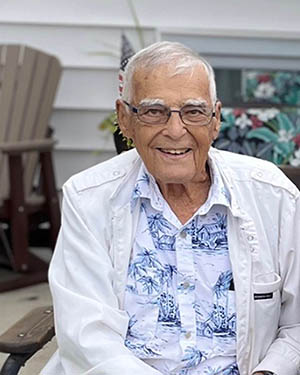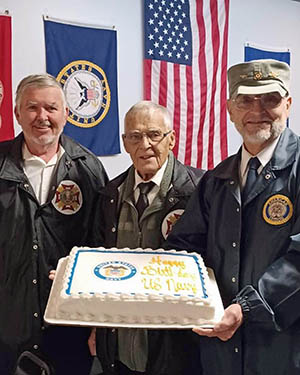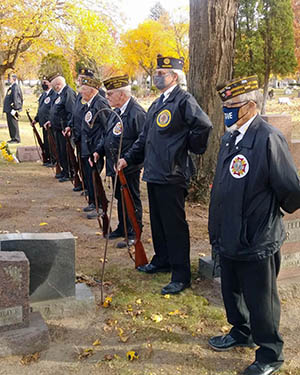Navy World War II / Korean War Mishawaka, IN Flight date: 10/18/23
By Al Rodriguez, Honor Flight Chicago Veteran Interview Volunteer
Talking with WWII Veteran Raymond Gervais, he said “I always wanted to be doing something”, from his WWII and Korean days, to playing volleyball in his 60’s, or working with his canine search and rescue team. He has certainly kept himself active.
Raymond can trace his North American roots to 1610 when his family moved from France to what is now known as Canada. Eventually the family migrated south into other French owned territories which eventually became the United States. His father’s family lived in Michigan and he fought in WWI with the Fighting 69th Army Engineers. Raymond was born in the Upper Peninsula in Michigan. When he was four years old his family moved from Michigan to South Bend, Indiana. His father went to work for the Studebaker Motor Company making prototype cars. In 1944 Raymond was a senior at Riley High School when he was drafted into the Navy. The need for military personnel was great at that time and he was told to report to the selective service office and would not finish his high school degree.
Raymond was sent to Great Lakes Training Center for basic training. He was then sent for training to Camp Bradford at Norfolk, Virginia, a training center for crews of LST’s, Landing Ship, Tanks. This is an Army Post where the Army, Navy and Marines practiced beach landings of troops and equipment on different types of landing craft, Landing Craft Tank, Landing Craft Vehicle Personnel and the Landing Ship Tank. The LST is the largest in this group measuring 328 feet by 50 feet wide. The LST is designed to carry troops and equipment on the deck or in the hold. While at Camp Bradford, he also received jungle warfare training in case he was needed for combat duty. He was sent back to Great Lakes Training Center for heavy artillery training on 20 millimeter, 5 inch guns.
After finishing his training, Raymond was assigned as a communications specialist to serve on the Navy ship LST-861. The crew was convoyed to Jeffersonville, Indiana, to pick it up and sail it to Panama City, Florida. He said it was a long journey that sent them down the Ohio River, the Mississippi River to a stop in New Orleans then on to Panama City, Florida. In Panama City they trained to beach the LST to unload troops and equipment. He said that the LST was designed to float like a cork to get it close enough to the beach. There was little danger of it sinking with large swells in the ocean even with heavy equipment strapped on the deck. Once they completed the training they sailed the LST through the Panama Canal with a stop at San Diego and then to San Francisco.
LST-861 was ordered for duty in the Pacific. Their final destination was the Navy Base Ulithi in the Ulithi Atoll. They loaded his ship with equipment needed in the Pacific theater of war, including six tanks chained to the deck. Raymond said it was a convoy of about 600 ships. Before reaching the Ulithi Atoll, they stopped to resupply in Hawaii. When they arrived at the Navy Base Ulithi, Raymond said it looked like there were thousands of ships in the harbor. One of his first duties was to deliver communication envelopes to the other ships. They would launch the smaller LCVP located on the LST to go from ship to ship in the harbor.



Early in 1945, LST-861 was sent to Leyte in support of the recapture of the Philippine Islands. They delivered 250 Marines from the 3rd Marine Division on Leyte’s south beach. One mission he remembers is when they were sent to pickup 500, 50-gallon gasoline drums from a freighter out at sea. Raymond said the drums were heavy and without a winch they had to be rolled onto their deck to be stored below, not the ideal way of handling them but they didn’t have any mishaps. When they reached the beach near the Leyte airport, the ship was too heavy and they couldn’t get close enough to the beach to unload. The Seabees had to build a temporary dock to unload the 25,000 gallons of fuel.
On April of 1945 LST-861 was ordered to deliver to Okinawa 200 of the 77th Army Infantry Division along with their equipment to yellow beach in Naha. The 77th had been fighting on Leyte and he said they looked pretty beat up but orders are orders. Although the Japanese reserved most of its offense inland, Raymond said that this was no walk on. The Japanese fired mortars and sniper fire at them as the men and equipment exited the LST, but they safely made it ashore. There were 2000 ships at Okinawa supporting the invasion. LST-861 was designated as the Fleet Mail Exchange ship. All incoming mail was sent to Raymond’s ship. He said they received a lot of letters and packages that would get dumped on their deck to sort and bag for the LCVP’s to pick up and deliver.
The fighting on Okinawa ended. Raymond was happy to hear that the Japanese surrendered. Even though the war was over they were kept in Okinawa. They sent the LST to pick up Japanese sailors and soldiers who were being held on Peleliu Island and return them to Yokohama Japan. They transported 800 Japanese fenced off on their deck. Raymond said most of them were in bad shape, starved and with sores all over their bodies. The one Japanese medic trying to help them had very few medical supplies and no clean or sterile gauze for their wounds. Raymond was on guard duty and saw the medic trying to clean a wound with a dirty rag. He motioned the medic over and was surprised he spoke English. He had studied at UCLA and was visiting Japan when the war started and was not allowed to leave. Raymond said he felt it was his Christian duty to help the prisoners and explained the situation to his Captain who agreed to let the medic take whatever medical supplies he needed.
Raymond said that while in Okinawa, it seemed like every week they were hit by a storm. There were 12 typhoons in that area in 1945. He said that all the ships would head out to sea to ride out the storm but still about 600 amphibian ships went aground throughout the Pacific. One particularly bad storm Typhoon Louise hit Japan shortly after the end of the war in October 1945. It caused extensive damage throughout the Pacific but especially Japan. As usual LST-861 and all the other ships at Okinawa went out to sea. They tried to stay on their given course but because of the huge waves it was hard to see the other ships around them. Luckily they had a good pilot who kept them on course within 2 to 3 degrees, heading them into the waves with the bow going up and over them. Raymond said that during the storm he never got sick, maybe because he only ate dill pickles and crackers which the cook would put out with cold cut sandwiches for whoever wanted to eat. To this day he says he still thinks of crackers and pickles as storm food. Raymond never slept during the 7 days they spent in the storm. He said after 48 hours in the storm he got a headache but it went away and then he was wide awake. His job was to walk around below deck checking for leaks. When the storm ended, he says he lay down on his cot on a Sunday and they woke him up on Wednesday.
On June of 1946, the LST-861 was on its way home and was sent to the Bikini Atoll but Raymond said that they didn’t witness any atomic explosions. They then went to Kwajalein Atoll to resupply their water supply. From there they went to Hawaii. Raymond boarded a passenger ship to San Francisco California for separation. He boarded a troop train for Great Lakes, Illinois, that had many stops and starts. After many days on the trip, the kitchen ran out of food and the sailors had to eat K Rations. They eventually get into Great Lakes and he made it home to South Bend, Indiana.
Raymond went to work at Studebaker until 1950 when he got called back to the Navy for the Korean War. Since he was a veteran with amphibious boat training he was sent to Quantico, Virginia, to help train Marine officers to make landings on Amtracs, amphibious assault vehicles and LSTs. The training took them to Vieques, Puerto Rico.
When the war ended in 1952 Raymond returned to South Bend and back to working at Studebaker. He went to night school to get his high school diploma. He married his girlfriend, Jane. Today he has five children, five grandchildren and two great-grandchildren. His family has multigenerational military veterans, his father a WWI Army Veteran, his brother a WWII Navy Veteran, one son a Navy Veteran and another an Army Veteran. He has one grandson who is a Navy Veteran.
In the late 1950’s Raymond left Studebaker to work at Curtiss-Wright Avionics Corporation, who at the time was developing a mobile missile, guided trucks. He left them to work at the State Department as a load maintenance engineer and worked his way up to chief inspector. He left them to work for the Wheelabator Frye Corporation which was one of the first plants to minimize its environmental footprint as a pollution control company. He worked for them until they moved the plant to another state.
In 1988 he retired and didn’t want to sit around. He joined the Coast Guard Auxiliary. He taught safe boating and water survival classes with the Department of Natural Resources for the states of Indiana and Michigan. He worked security for Notre Dame. Raymond owned Chesapeake Bay Retriever and boxer/shepherd mix dogs that were trained and nationally certified annually by the American Mantrailiing Police and Workdog Association. Each dog had a specific task that it would know and perform. He and his dogs participated in search and rescue, tracking and cadaver finding. Raymond and his team were called locally and throughout the country to help find fugitives and missing persons.
To stay active, Raymond jogged. When he was in his 60’s, he joined a volleyball team. He was the oldest member of his team, the Sensational Six and they played competitively against many younger teams. He said when they showed up for a tournament, they assumed that he was the coach. He’s a member of the VFW 360 and still participates in the Burial Squad. To date they’ve had 70 funerals.
Raymond has not been to D.C. since the 1980’s when he went to the Vietnam Veterans Wall Memorial. He is looking forward to seeing the WWII and the Korean Memorials.
Raymond, thank you for everything you’ve done for our country! Enjoy your day.


